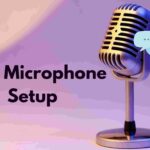To connect a microphone to a computer, plug the microphone into the computer’s audio input jack. Now let’s explore how to properly connect a microphone to your computer and start recording.
Whether you’re a podcaster, musician, or simply need to make audio recordings, connecting a microphone to your computer is a straightforward process. By following a few simple steps, you can begin capturing high-quality sound on your computer. One of the most common methods of connecting a microphone is by using the computer’s audio input jack.
This jack is usually color-coded pink and is found on the back or side of the computer’s tower. Simply plug the microphone’s audio cable into this jack, and you’ll be ready to start recording.
Also Read: Google home microphone not working?

Credit: restream.io
Table of Contents
Understanding Microphone Types
Microphones are essential tools for connecting to your computer and recording audio. There are several types of microphones available for computer use, each with its own unique features. Let’s explore the different microphone types to help you make an informed decision:
Usb Microphones:
- Usb microphones are the most common type of microphones used with computers.
- They are plug-and-play devices, meaning you can simply plug them into your computer’s usb port and start using them without any additional setup.
- They are convenient and portable, making them a popular choice for podcasters, youtubers, and voiceover artists.
- Usb microphones have built-in analog-to-digital converters, allowing you to directly record high-quality digital audio.
Xlr Microphones:
- Xlr microphones are professional-grade microphones commonly used in studios and broadcasting.
- They require an audio interface or a mixer with xlr inputs to connect to your computer.
- Xlr microphones offer superior audio quality and are highly versatile, allowing you to customize your sound using external equipment such as preamps and processors.
- They are preferred by musicians, vocalists, and audio professionals who require precise control over their recordings.
Wireless Microphones:
- Wireless microphones provide the freedom to move around without being tethered to your computer.
- They use radio frequency to transmit the audio signal from the microphone to a receiver connected to your computer.
- Wireless microphones are great for presentations, live performances, and video conferences.
- They come in various forms, such as handheld wireless microphones and lapel wireless microphones, offering flexibility for different recording scenarios.
Lavalier Microphones:
- Lavalier microphones, also known as lapel microphones, are small, clip-on microphones that can be attached to your clothing.
- They are commonly used in television production, interviews, and public speaking.
- Lavalier microphones are discreet and provide hands-free operation, making them ideal for situations where mobility and visibility are important.
- They can be wired or wireless, with the wireless option offering more freedom of movement.
With a wide range of microphone options available, selecting the right type for your computer is crucial for achieving optimal audio quality and convenience. Consider your specific recording needs, budget, and intended use to make an informed decision.
Choosing The Right Microphone
When it comes to connecting a microphone to your computer, choosing the right one is crucial to achieve high-quality audio. There are several factors to consider when selecting a microphone, including its purpose of use, budget, compatibility with your computer and software, and the recording environment.
Let’s delve into each of these factors to help you make an informed decision:
Factors To Consider When Selecting A Microphone
Purpose Of Use:
- Determine if you will use the microphone for recording vocals, instruments, podcasts, gaming, or streaming.
- Consider the specific requirements of your intended use to ensure the microphone can deliver the desired results.
Budget:
- Assess how much you are willing to invest in a microphone.
- Research different options within your budget range to find the best suited for your needs.
- Remember that higher-priced microphones may offer better sound quality and durability, but there are also excellent options available at more affordable prices.
Compatibility With Computer And Software:
- Check the compatibility of the microphone with your computer’s operating system.
- Ensure that it is compatible with the software you intend to use for recording or streaming.
- Some microphones have specific requirements or may require additional adapters or software installations.
Recording Environment:
- Consider the environment in which you will be recording.
- If you are in a noisy setting or have limited soundproofing, consider a microphone with good background noise cancellation capabilities.
- For professional studios or controlled environments, you may opt for a microphone with increased sensitivity and accuracy.
Remember, selecting the right microphone for your needs will significantly impact the quality of your recordings, streams, or podcasts. Take your time to research and choose wisely based on the purpose, budget, compatibility, and recording environment. Happy mic hunting!
Setting Up Your Computer For Microphone Connection
Steps To Prepare Your Computer For Connecting A Microphone:
To connect a microphone to your computer, you need to ensure that your system meets the necessary requirements, install any required drivers, and adjust your sound settings. Follow these steps to prepare your computer for a successful microphone connection:
Checking System Requirements:
Before connecting your microphone, ensure that your computer meets the following requirements:
- Check the compatibility of your microphone with your computer’s operating system.
- Verify if your computer has the necessary ports to connect the microphone.
- Ensure that your computer meets the minimum system requirements for the microphone you intend to use.
Installing Necessary Drivers:
To ensure proper functionality of your microphone, you may need to install specific drivers. Here’s what you need to do:
- Visit the manufacturer’s website and search for the latest drivers for your microphone model.
- Download the appropriate driver for your operating system. Make sure to choose the correct version (32-bit or 64-bit) based on your system’s specifications.
- Once downloaded, open the driver installation file and follow the on-screen instructions to install the drivers.
Adjusting Sound Settings:
To make sure your microphone works seamlessly with your computer, you may need to adjust the sound settings. Follow these steps to configure your sound settings correctly:
- Right-click on the sound icon in the taskbar and select “sounds.”
- In the “playback” tab, ensure that the correct speakers or headphones are selected as the default playback device.
- Navigate to the “recording” tab and select the microphone you want to use.
- Click on the “properties” button and adjust the microphone volume level as required.
- Enable any additional settings like noise cancellation or microphone boost if necessary.
- Test the microphone by speaking into it and monitoring the input level on the recording volume meter.
By following these steps, you will be able to prepare your computer for connecting a microphone successfully. Remember to always refer to the microphone manufacturer’s instructions for additional guidance if needed. Happy recording!
Connecting A Usb Microphone To Your Computer
Step-By-Step Instructions For Connecting A Usb Microphone:
To connect a usb microphone to your computer, follow these simple steps:
- Locate an available usb port on your computer.
- Take the usb cable that came with your microphone and plug one end into the microphone itself.
- Connect the other end of the usb cable to the usb port on your computer.
- Wait for your computer to recognize the usb microphone. It should automatically install any necessary drivers.
- Once the drivers are installed, your usb microphone is ready to use.
Plug And Play Setup:
Usb microphones offer a convenient plug and play setup, eliminating the need for additional software or complicated configurations. Here’s why this type of microphone is an excellent option for recording or streaming purposes:
- Ease of use: Usb microphones are designed to be user-friendly, making them suitable for beginners or those with limited technical background.
- Compatibility: Usb microphones are compatible with most operating systems, including windows, macos, and linux.
- Portability: These microphones are typically compact and lightweight, making them ideal for on-the-go use.
Troubleshooting Common Connection Issues:
While connecting a usb microphone is usually straightforward, you might encounter some common issues along the way. Here are a few troubleshooting tips:
- Check the usb cable: Ensure that the usb cable is securely connected to both the microphone and the computer. If the connection seems loose, try using a different usb cable.
- Restart your computer: Sometimes, a simple restart can resolve any software conflicts or issues with the usb port.
- Update drivers: Make sure you have the latest drivers for your usb microphone by visiting the manufacturer’s website and downloading any available updates.
- Try a different usb port: If your computer has multiple usb ports, try connecting the microphone to a different one to rule out any port-specific issues.
- Test with another device: If possible, test the usb microphone on another computer or device to determine if the problem lies with the microphone or your computer.
By following these steps and troubleshooting tips, you should be able to easily connect a usb microphone to your computer and start recording or streaming audio in no time. Happy recording!
Connecting An Xlr Microphone To Your Computer
Step-By-Step Instructions For Connecting An Xlr Microphone:
Connecting an xlr microphone to your computer requires a few simple steps. By using an audio interface, setting up phantom power, and ensuring your audio recording software is configured correctly, you’ll be ready to start recording in no time. Here’s a step-by-step guide to help you connect your xlr microphone to your computer:
Using an audio interface: An audio interface is necessary to connect an xlr microphone to your computer. Here’s how to do it:
- Connect one end of an xlr cable to the xlr output of your microphone.
- Connect the other end of the xlr cable to the xlr input of your audio interface.
- Plug the usb or thunderbolt cable from your audio interface into an available usb or thunderbolt port on your computer.
Setting up phantom power: Many xlr microphones require phantom power to function properly. To set up phantom power:
- Check if your audio interface has a phantom power switch. If it does, make sure it is turned on.
- If your audio interface doesn’t have a phantom power switch, you may need an external phantom power supply. Connect the phantom power supply to an electrical outlet, and then connect it to your audio interface using an xlr cable.
Configuring audio recording software: After connecting your xlr microphone to your computer, you need to configure your audio recording software. Here are the steps to follow:
- Open your audio recording software on your computer.
- Go to the preferences or settings menu, usually found under the “edit” or “file” tab.
- Select the audio input source as your audio interface.
- Adjust the input levels to ensure your microphone is not too quiet or too loud.
- Test the microphone by speaking into it and monitoring the audio levels on the software.
By following these step-by-step instructions, you can easily connect your xlr microphone to your computer. Remember to check the compatibility of your microphone with your audio interface and software before making any purchases. Now you’re ready to start recording high-quality audio for your podcasts, voice-overs, or music projects.
Connecting A Wireless Microphone To Your Computer
Step-By-Step Instructions For Connecting A Wireless Microphone:
Connecting a wireless microphone to your computer can provide you with the freedom to move around while recording or speaking. Here, we will walk you through the process step by step:
Ensure your computer has bluetooth capabilities: Check if your computer is equipped with built-in bluetooth or if you need to use an external bluetooth adapter.
Turn on your wireless microphone and receiver: Most wireless microphone systems have a power button on both the microphone and the receiver. Press the respective power buttons to turn them on.
Pairing the microphone and receiver: After turning on the microphone and receiver, they need to be paired. Follow these steps:
- On your computer, go to the bluetooth settings. This can typically be found in the system tray or in the settings menu.
- Enable bluetooth if it is not already enabled.
- On the microphone or receiver, locate the bluetooth pairing button. It is usually indicated by an icon or label.
- Press and hold the pairing button until the light indicator on the microphone or receiver starts blinking rapidly.
- In the bluetooth settings on your computer, look for the wireless microphone or receiver device and click on it to start the pairing process.
- Once the devices are successfully paired, the light indicator on the microphone or receiver should stop blinking rapidly and remain steady.
Adjusting frequency settings: In some cases, wireless microphone systems allow you to adjust the frequency settings for optimal performance. Refer to the user manual of your specific microphone system to learn how to access and adjust the frequency settings if necessary.
Troubleshooting interference issues: Wireless microphones can sometimes experience interference, resulting in static or poor audio quality. Here are a few troubleshooting steps you can take to minimize interference:
- Keep the microphone and receiver away from other electronic devices that may cause interference, such as routers, cordless phones, and wireless speakers.
- Make sure the microphone and receiver are in close proximity to each other for a reliable signal transmission.
- If there are multiple frequency channels available on your wireless microphone system, try switching to a different frequency to avoid interference from other nearby devices.
- Experiment with the positioning of the microphone and receiver to find the optimal setup for minimizing interference.
By following these step-by-step instructions, you can easily connect your wireless microphone to your computer and enjoy the convenience and flexibility it offers. Happy recording and speaking!
Connecting A Lavalier Microphone To Your Computer
Step-By-Step Instructions For Connecting A Lavalier Microphone:
Connecting a lavalier microphone to your computer is a simple process that can greatly enhance your audio recording capabilities. Whether you’re conducting interviews, recording podcasts, or giving presentations, a lavalier microphone is a convenient and hands-free option. Follow these step-by-step instructions to connect your lavalier microphone to your computer and start capturing high-quality audio.
Attaching The Microphone To Clothing:
- Locate the lavalier microphone: To begin, find your lavalier microphone. It is a small, clip-on microphone that can easily attach to your clothing.
- Choose the ideal location: Determine the best placement for the microphone on your clothing. Generally, it is recommended to position the microphone near the center of your chest, around 6-8 inches below your chin. This allows for clear and direct audio capture.
- Clip the microphone: Attach the clip of the lavalier microphone to your clothing at the selected location. Ensure that the microphone is securely fastened and that the microphone element is facing towards your mouth.
- Conceal the cable (optional): If desired, you can discreetly hide the microphone cable by running it under your clothing. This helps to prevent any distractions or interference during recording.
Connecting To A Wireless Transmitter Or Audio Interface:
- Identify the wireless transmitter or audio interface: Depending on your setup, you may be using a wireless transmitter or an audio interface. Locate the device that will enable the connection between your lavalier microphone and computer.
- Connect the microphone to the device: Plug the lavalier microphone into the corresponding input port on the wireless transmitter or audio interface. Typically, this port is labeled as “mic in” or “input.”
- Check the connection: Ensure that the lavalier microphone is securely connected to the device. Gently tug on the cable to confirm that it is firmly plugged in.
- Connect the device to the computer: Use an appropriate cable, such as a usb cable or audio cable, to connect the wireless transmitter or audio interface to your computer. Refer to the device’s user manual or instructions for specific guidance on the type of cable needed.
- Adjust audio settings: Once the connection is established, access your computer’s audio settings to select the lavalier microphone as the input device. This step may vary depending on your operating system and audio configuration.
With these step-by-step instructions, you can easily connect your lavalier microphone to your computer and begin capturing excellent audio quality. Whether you’re a content creator, presenter, or simply looking to enhance your audio recordings, utilizing a lavalier microphone provides a convenient and professional solution.
Troubleshooting Common Connection Issues
Common Problems And Solutions When Connecting A Microphone To A Computer
If you’re facing issues with connecting your microphone to your computer, don’t worry! We’ve got you covered. Here are some common problems that you might encounter along with their corresponding solutions:
No sound or low volume:
- Check if your microphone is properly connected to the computer’s audio input port.
- Ensure that the microphone is not muted or set to a very low volume level in the computer’s audio settings.
- Try using a different audio input port on your computer to see if it resolves the issue.
- Test the microphone on another device to determine if the problem lies with the microphone itself.
Noise or interference:
- Place your microphone away from any potential sources of interference, such as electrical devices or wi-fi routers.
- Use a shielded microphone cable to minimize the impact of electromagnetic interference.
- Adjust the microphone’s gain or sensitivity settings to reduce background noise.
- Consider using a microphone with noise-cancellation capabilities to minimize unwanted noise.
Incorrect device recognition:
- Ensure that the microphone is compatible with your computer’s operating system.
- Install the necessary drivers or software provided by the microphone manufacturer to enable proper device recognition.
- Restart your computer and check if the microphone is detected.
- Connect the microphone to a different usb port to rule out any port-specific issues.
By following these troubleshooting tips, you should be able to resolve most common connection issues when connecting a microphone to your computer. Remember to double-check your connections, adjust settings, and consider any potential sources of interference. Happy recording and communicating!
Tips For Optimal Microphone Setup And Performance
Proper microphone setup is crucial for achieving the best audio quality in your recordings. From microphone placement to using the right accessories, here are some tips to help you get the most out of your microphone:
Best Practices For Achieving The Best Audio Quality:
- Position the microphone at the correct distance from your mouth: To ensure clear and balanced audio, try placing the microphone about 4 to 6 inches away from your mouth. This distance may vary depending on the specific microphone and your speaking volume.
- Adjust the microphone angle: Point the microphone towards your mouth to capture your voice accurately. Avoid speaking directly into the top or bottom of the microphone as this can cause audio distortion.
- Use a microphone stand or boom arm: A stable microphone stand or boom arm can help reduce unwanted vibrations and handling noise. Make sure to choose a sturdy and adjustable stand that suits your setup.
Proper Microphone Placement:
- Consider using a shock mount: A shock mount helps isolate the microphone from vibrations and reduces unwanted noise. This accessory is particularly useful when recording in a room with various ambient sounds or with a setup prone to vibrations.
- Avoid placing the microphone near noisy devices: Keep the microphone away from computer fans, air conditioning units, or any other sources of noise that can interfere with your recording. This precaution will help you achieve a cleaner and more professional sound.
- Experiment with different room positions: Depending on the room’s acoustics, you may need to try various positions to find the optimal placement for your microphone. Test recording in different areas of the room to identify the spot with the best sound quality.
Using A Pop Filter Or Windscreen:
- Prevent plosive sounds with a pop filter: A pop filter is a screen placed in front of the microphone to reduce strong bursts of air caused by “p” and “b” sounds. It helps eliminate those unwanted plosive sounds, resulting in a smoother and more pleasant recording.
- Reduce wind noise with a windscreen: If you’re recording outdoors or in a windy environment, attach a windscreen to your microphone. This foam cover acts as a shield against wind noise, ensuring your recordings are clear and distortion-free.
Recording In A Quiet Environment:
- Minimize background noise: Find a quiet space to record your audio. Close windows to reduce the sound of traffic or outdoor activities. Silence your phone and any other devices that may produce distracting sounds.
- Use soundproofing techniques: If you’re experiencing excessive background noise, consider using soundproofing techniques. Use curtains, carpets, or acoustic panels to absorb echoes and reduce external noises that can affect your recordings.
Remember, achieving the best audio quality involves a combination of proper microphone setup, placement, and environmentally conscious recording practices. By implementing these tips, you can enhance your microphone’s performance and ensure your recordings sound professional and polished.
Frequently Asked Questions On How to Easily Connect Microphone to Computer
How Do I Connect A Microphone To My Computer?
Connecting a microphone to your computer is easy. Simply plug the microphone into the appropriate port on your computer. Many computers have a dedicated microphone input, while others may require a usb connection. Once connected, your computer should recognize the microphone, and you can start using it for recording or communication purposes.
What Type Of Microphone Should I Use For My Computer?
The type of microphone you should use for your computer depends on your specific needs. If you want to record vocals or instruments, a condenser microphone is a popular choice. For voice calls or streaming, a headset with a built-in microphone is convenient.
Usb microphones are also a good option for their ease of use and compatibility with most computers.
Why Is My Microphone Not Working On My Computer?
If your microphone is not working on your computer, there could be several reasons. First, ensure that your microphone is properly connected to your computer. Check the volume settings and make sure the microphone is not muted. Additionally, check your computer’s audio settings and ensure that the correct input device is selected.
If the issue persists, try updating your audio drivers or troubleshooting with the manufacturer’s instructions.
How do I physically connect my microphone to my computer?
Connect your microphone to your computer using the appropriate cable. Most microphones use a USB or 3.5mm audio jack. If it’s a USB microphone, simply plug it into an available USB port. For 3.5mm microphones, use the microphone port on your computer, typically marked with a microphone icon.
How do I check if my computer recognizes the microphone?
Go to your computer’s settings or control panel and navigate to the “Sound” or “Audio” settings. Look for your microphone in the list of input devices. If it’s recognized, you should see it listed. If not, ensure the microphone is properly connected and try a different USB port or audio jack.
How do I adjust microphone settings on my computer?
Access your computer’s sound settings and locate the microphone settings. You can usually adjust the microphone volume and sensitivity here. Additionally, some microphones have their own settings, accessible through dedicated software that might come with the microphone.
My computer has multiple microphones listed. How do I know which one is active?
In your computer’s sound settings, the active microphone should be set as the default recording device. Look for a green checkmark or the word “Default” next to the active microphone. If needed, you can change the default microphone by right-clicking on the desired device and selecting “Set as Default.”
How do I test my microphone to ensure it’s working correctly?
Use your computer’s built-in voice recorder or a third-party application to record a short audio clip. Play it back to check for sound quality and ensure that the microphone is functioning properly. You can also use online platforms or applications that offer microphone testing services.
What should I do if my microphone is not working?
Check the physical connection, try a different USB port or audio jack, and ensure the microphone is powered (if applicable). Verify that the microphone is selected as the default recording device in your computer’s sound settings. If problems persist, consult the microphone’s user manual or contact technical support.
How can I reduce background noise during microphone use?
Consider using a microphone with noise-canceling features. Additionally, adjust microphone sensitivity settings in your computer’s sound settings to minimize background noise. If possible, use a pop filter or place the microphone closer to your mouth while speaking to improve signal-to-noise ratio.
Can I use a Bluetooth microphone with my computer?
Yes, you can use a Bluetooth microphone with your computer if it has built-in Bluetooth capability. Pair the microphone following the manufacturer’s instructions, and select it as the default recording device in your computer’s Bluetooth settings.
How do I update microphone drivers on my computer?
To update microphone drivers, go to the Device Manager on your computer, find the audio or sound section, right-click on your microphone, and select “Update driver.” You can choose to search for updated drivers automatically or manually download and install them from the manufacturer’s website.
Also Read: If your Iphone Microphone Not Working ! How to Fix
Conclusion
Connecting a microphone to your computer is a simple process that can enhance your audio experience. By following these steps, you can ensure a seamless connection and enjoy improved sound quality for a variety of purposes. First, gather the necessary equipment, such as a microphone and an audio interface or usb adapter.
Ensure that the microphone is compatible with your computer. Next, connect the microphone to the computer using the appropriate cables. Once connected, adjust the microphone settings in your computer’s sound preferences. Test the microphone to ensure it is functioning properly, and make any necessary adjustments to the volume or settings.
With your microphone successfully connected to your computer, you can now confidently use it for activities such as podcasting, recording music, or video conferencing. Whether you are a content creator, musician, or simply someone who wants better audio quality, connecting a microphone to your computer opens up a world of possibilities.

Williams Kane is a blogger and writer. He’s passionate about writing and connecting with the community, especially when it comes to sharing his ideas through writing.
I am a versatile author with a passion for exploring a wide range of topics on our multi-niche website. With a background in research and a love for writing, I bring a unique blend of expertise to our platform.
My journey began in the world of science, where I earned a degree in biology and developed a deep fascination for the natural world. This background enables me to delve into topics related to ecology, environmental conservation, and the wonders of the animal kingdom.
However, my curiosity knows no bounds, and I have ventured into various other niches as well. From technology trends and digital innovations to health and wellness tips, I strive to provide well-researched and engaging content that informs and entertains our diverse audience.
Furthermore, my dedication to staying current with the latest developments in each niche ensures that our readers receive up-to-date and reliable information. Whether it’s deciphering complex scientific concepts or simplifying tech jargon, I take pride in making complex subjects accessible to all.
Join me on our multi-niche journey, where we explore the depths of knowledge and share insights on a multitude of topics to inspire, educate, and entertain.




